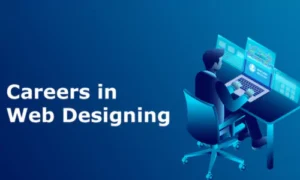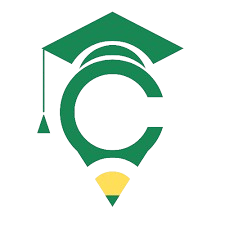Recently updated on June 22nd, 2025 at 12:27 pm
In today’s digital world, every business, brand, and even individual needs a strong online presence, and that starts with a website. But creating a website is not just about making it look good. It’s about functionality, user experience, and performance. That’s where web design and development come in.
Whether you’re a student exploring career options, a job seeker wanting to upskill, or an entrepreneur wanting to understand how websites work, this blog will give you a clear idea of what web design and development are, how they are useful, and what kind of jobs you can do in this field.
1. What Is Web Design?

Web design refers to the visual aesthetics and usability of a website. It’s about how the site looks and how users interact with it. Web designers use design tools (like Figma, Adobe XD, or Canva) and front-end technologies (like HTML, CSS, JavaScript) to bring a website to life.
Key Elements of Web Design:
- Layout – Structure and placement of elements (text, images, buttons).
- Colour Scheme – Consistent use of brand colours to create mood and tone.
- Typography – Font styles that ensure readability and brand alignment.
- Responsiveness – Design that works across devices (mobile, tablet, desktop).
- User Experience (UX) – Ensuring visitors enjoy using the website.
2. What Is Web Development?

Web development focuses on the functionality and logic behind a website. It’s the technical part of making the website work—loading pages, processing forms, integrating with databases, etc.
There are two main types:
- Front-End Development: Deals with the client side (what users see). Uses HTML, CSS, JavaScript, and frameworks like React, Angular, or Vue.
- Back-End Development: Deals with the server side (how the site works behind the scenes). Uses languages like PHP, Python, Node.js, Ruby, etc., and databases like MySQL or MongoDB.
Also See: 10 Short-Term Courses After 12th
3. Why Is Web Design & Development Useful?
- Essential for Businesses: Every brand needs a website to attract customers and build trust.
- High Demand: With more businesses going digital, there’s constant demand for skilled web professionals.
- Creative + Technical: Offers a perfect mix of art and coding—ideal for both left-brain and right-brain thinkers.
- Freelance & Remote Opportunities: Work from anywhere, for clients worldwide.
- Entrepreneurship: Build your products, eCommerce stores, or blog platforms.
4. What Jobs Can You Do in Web Design & Development?

This field opens doors to many job opportunities:
1. Web Designer
- Focuses on designing website layouts and visuals.
- Tools: Figma, Adobe XD, Sketch.
2. Front-End Developer
- Builds the user-facing side of websites.
- Skills: HTML, CSS, JavaScript, React/Vue.
3. Back-End Developer
- Handles databases, servers, and application logic.
- Skills: Node.js, PHP, Python, SQL.
4. Full-Stack Developer
- Combines front-end and back-end knowledge.
- Ideal for small companies or startups.
5. UI/UX Designer
- Focuses on improving user experience and interface flow.
- Conducts research, builds wireframes, and prototypes.
6. WordPress Developer
- Builds websites using WordPress CMS.
- Ideal for bloggers, small businesses, and freelancers.
7. Freelance Web Developer
- Works independently on client projects.
- Can set your prices and schedule.
8. Web Project Manager
- Oversees a team of designers and developers.
- Requires experience and communication skills.
Conclusion
Web design and development is a powerful and rewarding career path. Whether you’re passionate about art and creativity or logic and coding, there’s a role for you in this field. With the growing demand for digital transformation, mastering web design and development can lead you to a fulfilling career, be it as an employee, freelancer, or entrepreneur.







80gamesvip
June 19, 2025Alright folks, 80gamesvip showed promise. The VIP aspect is kinda cool, but the game selection needs a bit more oomph. Still, worth checking out if you’re looking for something a bit different. You can find it at 80gamesvip.
xn88 đăng nhập
June 19, 202566b uy tín không chỉ tập trung vào việc cung cấp dịch vụ cá cược, mà còn chú trọng vào chất lượng trải nghiệm người dùng, bao gồm giao diện thân thiện và hỗ trợ khách hàng. Điều này khiến người chơi cảm thấy thoải mái và an toàn hơn khi tham gia các hoạt động giải trí trên trang web.
xn88 slot
June 19, 2025tải 888slot Sau khi điền xong các thông tin cần thiết, bạn cần kiểm tra lại để đảm bảo không có sai sót. Tiếp theo, bạn sẽ nhấn vào nút “Đăng ký” để hoàn tất quá trình. Một số trường hợp, hệ thống có thể yêu cầu xác minh qua mã OTP gửi về số điện thoại hoặc email để tăng cường bảo mật.
đăng ký 66b
June 19, 2025Một số dòng game nổi bật phải kể đến tại xn88 app com phải kể đến như baccarat, rồng hổ, xì dách, xóc đĩa, xì tố, poker,….đều có mặt. Các dealer nữ xinh đẹp, được đào tạo bài bản chuyên nghiệp, nóng bỏng luôn đồng hành và chắc chắn không làm anh em thất vọng.
slot365 đăng nhập
June 19, 2025Các giấy phép này cũng yêu cầu ưu đãi 188v phải thực hiện các biện pháp bảo vệ người chơi, như bảo mật thông tin cá nhân, chống gian lận, và đảm bảo công bằng trong trò chơi. Điều này giúp người chơi yên tâm hơn khi tham gia cá cược tại nhà cái.